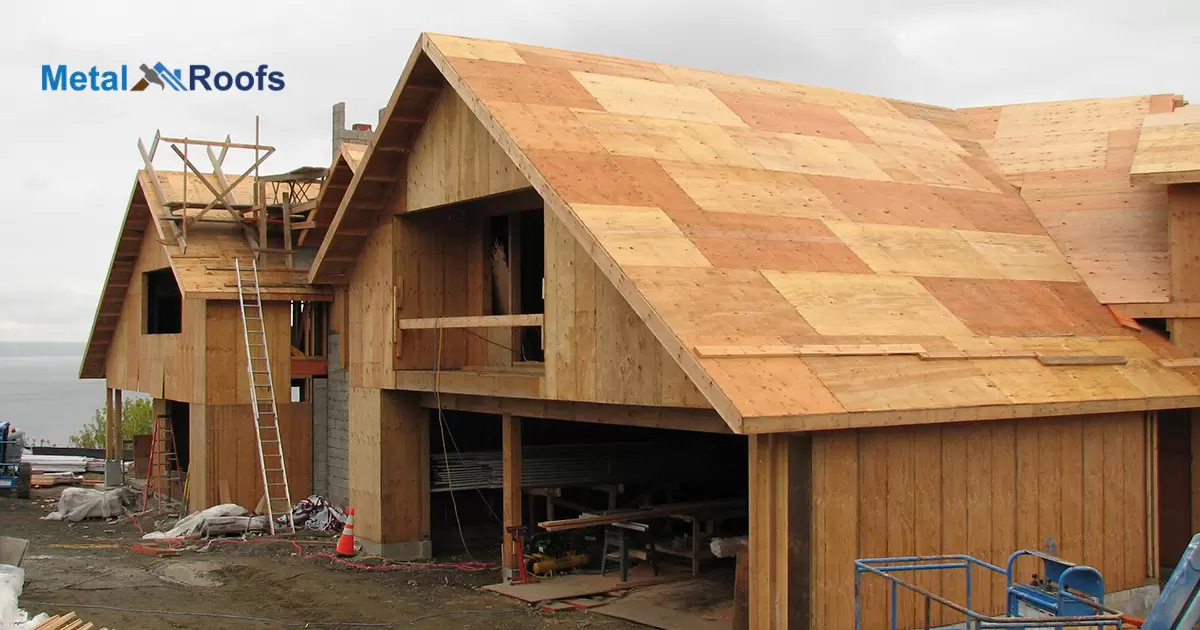Metal roofing installed right on top of plywood decking, without any underlayment or spacer, allows for condensation buildup and rot over time. The plywood needs protection from moisture before metal roofing goes on to prevent issues down the road.
Metal roofing brings durability. But mistakes install it. Like on plywood alone. That invites wet rot as condensation has no escape. So can you put metal roofing directly on plywood? You can, but should not without protection.
To enhance insulation, attach foam board insulation to the metal roof between the plywood and the roofing material. This helps create an air gap, preventing condensation buildup and potential rotting issues. Ideal spacers like roofing felt or synthetic underlayment also protect the plywood deck.
Key Takeaway
- Use plywood for a stable metal roofing foundation
- Confirm feasibility of durability
- Ensure a reliable structure with proper installation
Benefits of Metal Roofing Installation
| Benefits | Description |
| Durability | Long lifespan and resistance to weather damage |
| Energy Efficiency | Reflects sunlight, reducing cooling costs |
| Low Maintenance | Requires minimal upkeep and repairs |
| Environmentally Friendly | Recyclable material, reducing environmental impact |
| Fire Resistance | Non-combustible, enhancing safety |
| Increased Home Value | Adds value to the property |
Metal roofing brings durability. It resists rust and can endure harsh weather, saving you money on repairs. With its long lifespan, metal roofing provides a lasting shield against the elements.
Installation is swift, reducing disruptions. The lightweight material simplifies the process, of completing your roof project efficiently. Choose metal roofing for a sturdy, reliable shelter.
Energy efficiency is a bonus. Reflecting the sun’s rays, metal roofing keeps your home cooler, slashing energy bills. It is eco-friendly, often containing recycled materials. Opt for metal roofing to enhance sustainability and cut down on long-term energy costs.
Preparation for Metal Roofing Installation
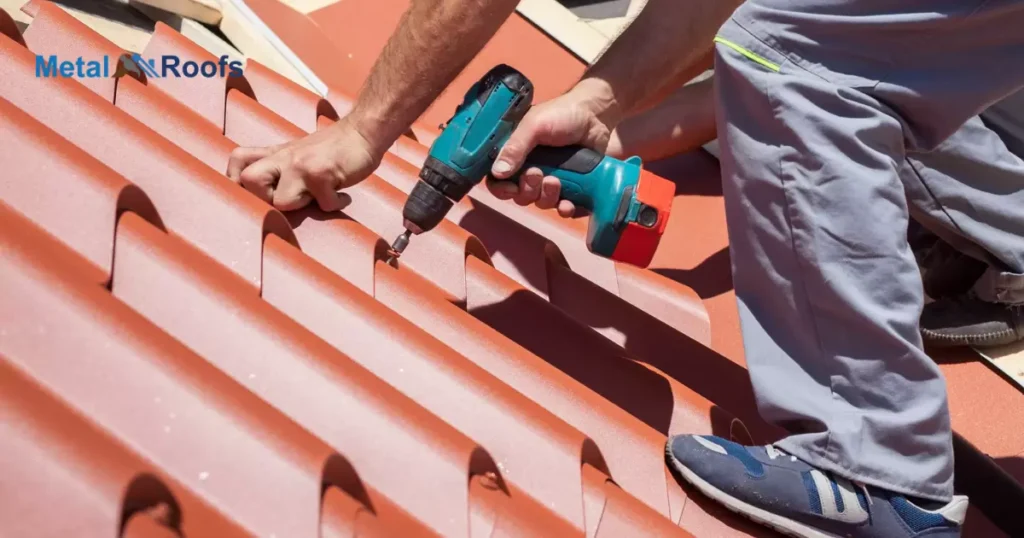
Start by clearing the roof. Remove old shingles and debris. Check for any repairs needed. Ensure a smooth surface for metal installation. Next, measure accurately. Precision is key. Order materials accordingly.
Plan for overlaps and edges. Avoid wastage and delays. Secure the framework tightly. Use screws, not nails. Ensure a strong foundation. This step is crucial for durability. Follow these steps for a successful metal roofing installation.
Choosing the Right Metal Roofing
Preparation for metal roofing installation is crucial for a successful project. Begin by clearing the roof of old shingles and debris, ensuring a clean slate. Accurate measurement is key order materials precisely, accounting for overlaps and edges to minimize wastage. Prioritize a secure framework, opting for screws over nails for a robust foundation.
Inspecting and Repairing the Plywood
Clear the roof of debris, removing old shingles. Accurately measure and order materials for precise metal installation. Secure the framework tightly using screws for durability. Inspect and repair plywood, ensuring a strong foundation for a successful metal roofing installation.
Is It Safe to Install Metal Roofing Directly on Plywood?
Consider safety when installing metal roofing. Ensure plywood is in good condition. Weak spots may compromise stability. Address any issues before proceeding. Installing directly on plywood is common. Check manufacturer guidelines.
Some may recommend an underlayment. Prioritize safety and follow guidelines for a secure metal roofing installation. Assess local building codes. Compliance is crucial for safety and legal requirements.
Some areas mandate specific underlayment or insulation. Confirm your installation aligns with these regulations. Prioritize a secure foundation and adherence to guidelines for a safe and lasting metal roofing installation.
Install Metal Roofing Over Plywood Step-by-Step
Begin by laying down a waterproof underlayment. Ensure complete coverage over the plywood. This creates a barrier against moisture.
Next, start installing metal panels from one edge. Overlap each panel for a watertight seal. Use screws to secure them in place. Repeat until the entire roof is covered.
Pay attention to details around vents and edges. Trim panels as needed for a neat finish. Finally, step back and admire your new, sturdy metal roof. The process is simple when you follow these steps sequentially.
Metal Roofing Installation Process
Start by clearing the roof of old materials. Measure accurately and order the needed metal roofing materials. Ensure a solid framework, securing it tightly with screws. Lay down the metal sheets, overlapping for a watertight seal. Attach securely, ensuring stability against weather elements.
Continue by adding flashing around edges and openings. This safeguards against leaks. Seal seams with care, enhancing the roof’s durability. Double-check each step for precision. A systematic approach ensures a successful metal roofing installation, providing long-lasting protection for your structure.
1- Measuring and Marking
Begin by measuring accurately. Precision is key in metal roofing. Mark the measurements clearly for reference. This ensures a seamless and well-fitted installation. Double-check your markings. Confirm accuracy before cutting materials.
2- Applying Plywood Roof Underlayment
Before metal roofing, apply plywood underlayment. Ensure a smooth, even surface. This adds a protective layer against moisture. Secure it tightly to the roof’s framework. Start at one end, rolling out the underlayment carefully. Overlap seams to prevent leaks. Nail it down securely, avoiding any wrinkles.
3- Attaching the Metal Roofing
Secure the metal sheets tightly. Use screws for a robust attachment. Ensure an overlapping pattern, creating a weather-resistant seal. This step guarantees a watertight and durable roofing structure.
4- Finishing Touches
Complete the process with essential finishing touches. Inspect for any loose screws or edges that need attention. Ensure all seams are sealed for maximum weather resistance. A thorough check guarantees a secure and well-installed metal roof.
What Materials Are Needed to Install Metal Roofing on Plywood?
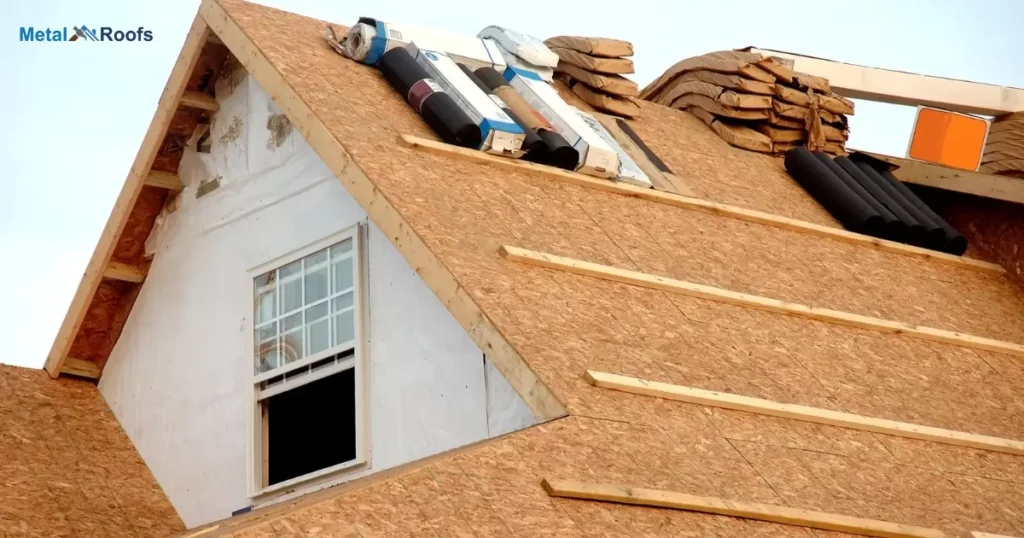
To install metal roofing on plywood, gather essential materials. Start with the metal panels – choose a durable material like steel or aluminum. Ensure you have enough panels for full coverage, measuring accurately.
Next, secure the right fasteners opt for screws, not nails, for a robust attachment. Check that you have enough to secure the entire roofing surface. Additionally, obtain sealant or caulk to weatherproof the seams and edges, preventing leaks.
Lastly, make sure to have the necessary tools a drill for fastening, a measuring tape for precision, and safety gear such as gloves and safety glasses. With these materials in hand, you’re ready for a successful metal roofing installation on plywood.
Why Use Protective Layers When Installing Metal Roofing on Plywood?
Start by understanding the importance of protective layers. These layers shield plywood from weather damage. Apply a waterproof barrier first, preventing moisture penetration. This safeguards against rot and extends the life of your plywood.
Use an underlayment for added protection. It acts as a secondary defense against leaks. Choose a suitable underlayment material, considering your climate. Protective layers are essential for the longevity and resilience of your metal roofing installation on plywood.
Advantages of Installing Metal Roofing Over Plywood
Metal roofing offers durability. It outlasts traditional materials like shingles. With proper installation on plywood, it becomes a long-term solution. The robust nature provides excellent resistance against harsh weather conditions.
Moreover, metal roofing is low maintenance. Say goodbye to frequent repairs. It’s resistant to rot and insects. This translates to cost savings over time. Installing metal roofing over plywood is a wise investment, ensuring a resilient and hassle-free roof for years to come.
Common Mistakes to Avoid When Installing Metal Roofing Over Plywood
Begin by checking the plywood thoroughly. Avoid installing on damaged or weak areas. Ensure a solid foundation for the metal roofing. Measure accurately to prevent material shortages. Overlapping is key for a watertight seal.
Avoid underestimating quantities to prevent delays. Secure metal panels tightly, using screws not nails. Incorrect fastening can lead to issues. Pay attention to details for a successful and durable installation.
Long-Term Impact Metal Roofing Installation Directly on Plywood
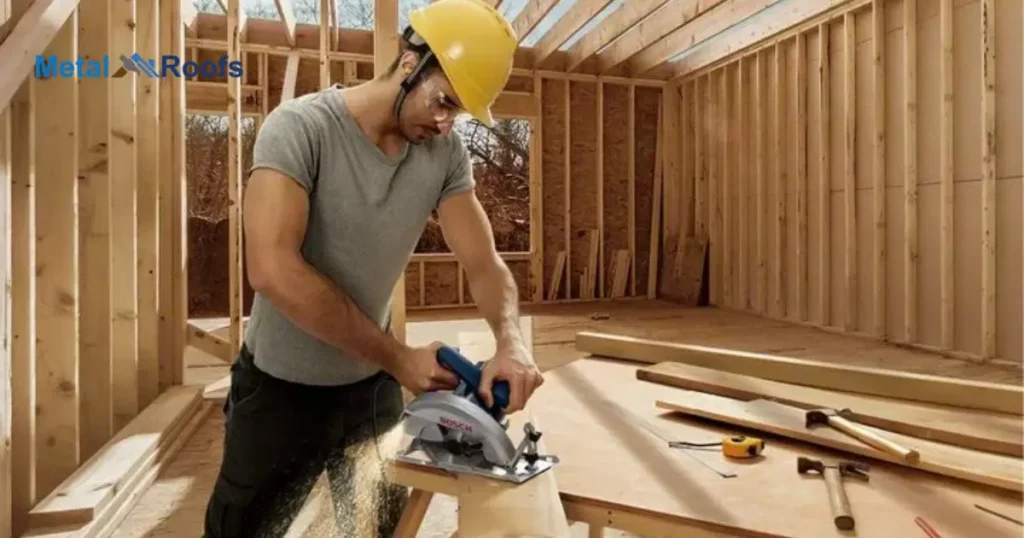
Metal roofing, when installed directly on plywood, offers lasting benefits. Its durability shields the plywood from weather damage, extending the roof’s lifespan. This shields the structure from leaks and rot, promoting long-term stability.
The low maintenance of metal roofs reduces future costs. They resist corrosion, preventing the need for frequent repairs. In essence, a metal roof installation directly on plywood not only enhances structural longevity but also proves cost-effective in the long run.
Metal Roof On Plywood Or Osb
Ensure a solid base for your metal roof by installing it on plywood or OSB. These materials provide a sturdy foundation. Plywood, known for its strength, is a common choice. OSB, an engineered wood product, also offers reliability.
Before installation, inspect the plywood or OSB for any issues. Repair or replace damaged sections to guarantee a secure and durable foundation. A well-prepared base ensures the longevity and stability of your metal roofing system.
How To Secure Metal Roofing?
Start by laying the metal sheets horizontally, overlapping them slightly. Use screws, not nails, for a secure hold. Place screws in the valleys to prevent water buildup. Ensure screws penetrate the roof deck for maximum stability.
Next, secure the ridge cap at the roof’s peak. Overlap the caps, fastening them with screws. This creates a watertight seal. Confirm all edges and seams are tightly secured. Following these steps ensures a robust and enduring installation of metal roofing.
Wood To Use Under Metal Roof
Select suitable wood for metal roofing. Plywood of at least 1/2 inch thickness is ideal. OSB (oriented strand board) is also a good option. Ensure the wood is an exterior grade for weather resistance.
Avoid using interior-grade plywood. It lacks the durability needed for outdoor exposure. Opt for pressure-treated or rot-resistant wood for longevity. The right wood choice is essential for a stable and enduring foundation under the metal roof.
Plywood Vs Purlins Under Metal Roofing
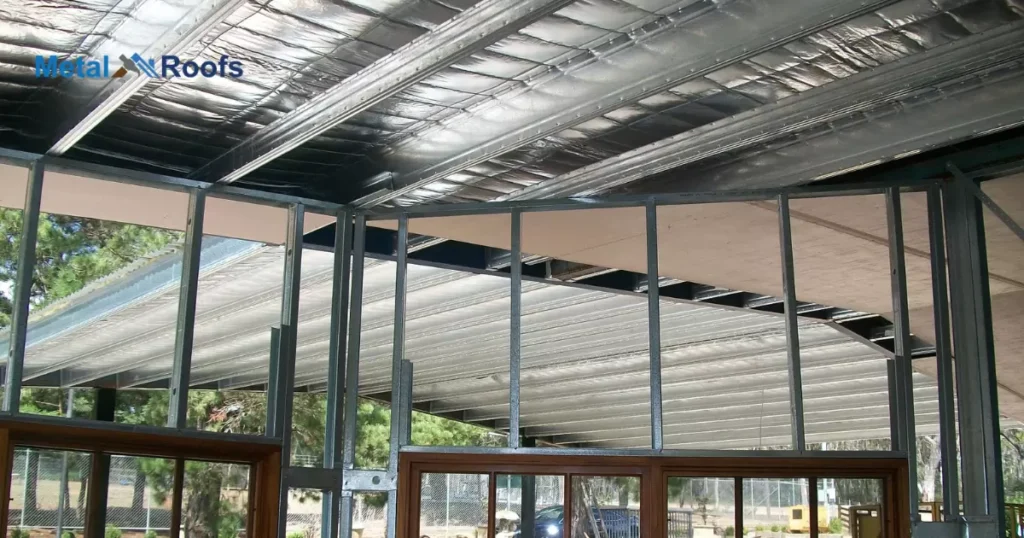
Choose between plywood and purlins wisely. Plywood offers a solid base, crucial for stability. It’s suitable for various roof types. Ensure proper thickness for optimal support.
On the other hand, purlins are horizontal beams. They provide a cost-effective alternative. Install them correctly for proper weight distribution. Consider your specific needs when deciding between plywood and purlins for a reliable metal roofing foundation.
Putting On Metal Roofing
Putting on metal roofing requires careful steps. First, inspect the plywood. Make sure it is sturdy and free of damage. Next, add a roofing underlayment. This layer protects against moisture and helps with temperature control. It also reduces noise. Secure the underlayment tightly. Now, you are ready to install the metal panels.
Start by aligning the first metal panel at one edge of the roof. Use screws to attach it firmly. Overlap each new panel slightly over the previous one. This prevents leaks. Work your way across the roof. Once all panels are in place, check for gaps or loose screws. Fix any issues to ensure a solid roof.
Install Metal Roofing Over Plywood
Installing metal roofing over plywood is possible. First, ensure the plywood is strong and in good shape. Clean it to remove any debris or old nails. Next, place a roofing underlayment on the plywood. This underlayment acts as a moisture barrier. It also helps with temperature control. Secure the underlayment well to the plywood.
Now, you can begin installing the metal roofing. Align the metal panels with the roof edge. Attach them using screws made for metal roofing. Make sure to follow the manufacturer’s instructions. Overlap the panels to prevent leaks. Finally, check for any gaps or loose areas and fix them. This will ensure a sturdy and long-lasting roof.
Frequently Asked Questions
How do you attach a metal roof to plywood?
Use screws to firmly attach the metal roof to the plywood, ensuring a secure and durable connection.
Should I put plywood under my metal roof?
Yes, plywood is recommended for a solid and stable foundation under a metal roof. It provides essential support and ensures durability.
Do you need to put anything under a metal roof?
Yes, a solid base is essential. Consider options like plywood or purlins for stability and support.
Conclusion
Installing metal over plywood is not odd. But leave an air gap. Use roofing felt for this. Or synthetic underlayment works too. This protects from condensation. Ensures plywood lasts over time. Prevents issues like mold and rot later.
An airspace is vital under metal roofing. Felt or synthetic underlayment makes it. Failing to do this risks major trouble. This could lead to replacing compromised decking prematurely. Proper installs avoid problems. Bring long-term savings. And let you enjoy durability benefits of metal.
